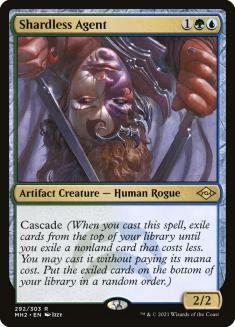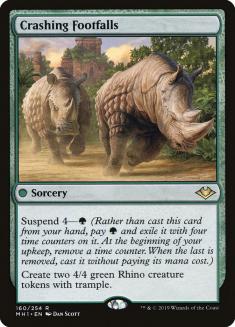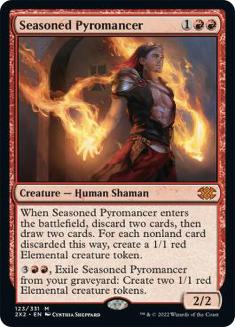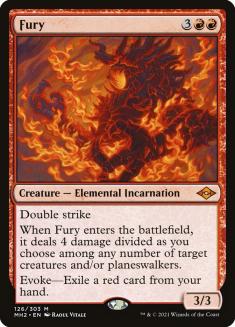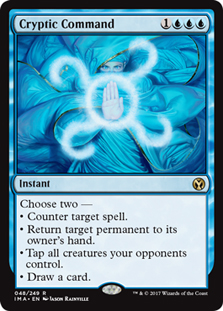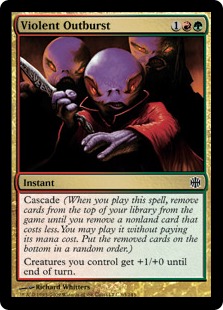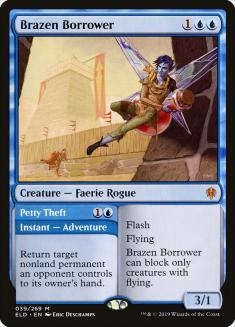Temur Crashcade has been one of my favorite Modern decks since Shardless Agent was printed into the format.
The mini-combo of cascade spell into Crashing Footfalls allows you to cut all the combo nonsense from your deck in favor of cheeky interaction. We have to be pretty specific on what types of interaction we play (mana value three or greater), but Modern is stuffed with reduced cost spells and alternate casting costs, so much so that you can build a truly functional deck that easily beats the mana value requirement.
What starts off seeming like a combo deck ultimately ends up being an archetype built around a lot of powerful three-mana spells. Imagine playing a deck where most of your three-mana spells did something outlandish, but it comes at the loss of Lightning Bolt and Counterspell. Instead, we’re forced to be a little creative, using spells like Dead // Gone and Brazen Borrower to let us cheat on interaction in the early turns.
What ends up happening is we get a deck with a focal point: Shardless Agent or Violent Outburst. Once we cast one of those spells, we burst onto the scene with two Rhino tokens, ultimately generating a ton of pressure for a very small investment. Because the spell we’re casting is so compact, only requiring itself and four copies of Crashing Footfalls, the rest of our deck doesn’t have to be dedicated to being combo-oriented. We get to surround our mini-combo with a ton of interaction, to the point where our deck starts to look and feel a lot like Splinter Twin.
Combo/control, a deck that gets to play a control game until it ultimately wins with a combo finish, is one of the strongest archetypes in Magic. The fewer combo cards needed for deck construction, the more interaction you can play. When your combo can be supported by a great number of interactive spells, that makes the combo itself stronger and less detrimental when you draw extra pieces or get hit with pinpoint disruption.
Two large Rhinos on the third turn isn’t exactly game over in Modern. You need to protect yourself from combos and creatures, which requires filling your deck with removal and Force of Negation. That’s why we’re not a true combo deck in the literal sense. Our combo is casting a single card, similar to the Gyruda, Doom of Depths decks that popped up during the companion era. Because our combo takes so little investment, we’re free to use the rest of our deckbuilding slots to create pockets of pressure or disruption where our Rhinos can thrive.
Don’t Fight the Current
Kyle Boggemes is name that should ring a few bells when talking about the SCG Tour. When he’s playing the game every week, you would be wise to copy his decklists and heed his words. For the Star City Games Invitational on Halloween weekend, I will be playing his version in the Modern portion of the tournament with very minor changes. For now, let’s look at his list.
Creatures (15)
Lands (24)
Spells (21)
Sideboard

Seasoned Pyromancer has picked up some steam in these lists as of late, and for good reason. It is one of the better three-mana threats in Modern, and especially so if your deck is full of redundant or expensive spells. The extra bodies you generate can help overwhelm spot removal, and turning mediocre threats or answers into actionable content is clutch. Seasoned Pyromancer is currently taking the place of Bonecrusher Giant, and I think it has earned that slot.
The two damage from Stomp is why Bonecrusher Giant was in the original lists, but that effect is just too ineffecient and/or weak to make the cut these days. While Seasoned Pyromancer doesn’t have the variable cost of two or three mana like Bonecrusher Giant, the effect it offers is unique and the most effecient while still meeting our mana value requirements.
Cards like Seasoned Pyromancer help our “mini-combo” deck become a more resilient fair strategy. The first few matches I played with Temur Crashcade a few months back, I felt like I couldn’t win the game if I didn’t cast Crashing Footfalls within the first three or four turns. Nowadays I feel like playing the game is pretty easy, and the occasional Crashing Footfalls on the third turn makes life for my opponent that much harder. It’s incredible how much differently games or matches can go when you build your combo deck to withstand a barrage of pressure, interaction, and even defensive measures. That’s the beauty of Temur Crashcade, and why the deck continues to be a dominating force in Modern. That inherent flexibility to adapt to certain problems means we can adapt and make those problems irrelevant.
Fury is one of the cards that has helped us overcome some of our inherent weaknesses. Since we can’t play many spells that costs one or two mana, thanks to Cascade, we are forced to look for cards with alternate casting costs so we can “cheat.” Fury is one of the new Elemental Incarnations and boy does it absolutely smash aggro, one of the core archetypes in Modern that can potentially overwhelm us thanks to our decks substantial drawback. Our weak or nonexistent early interaction often leads to our destruction at the hands of creature-based decks. Fury circumvents that, giving us a way to sweep away a swarm of little monsters without breaking our deck’s mana value contract.
Fury gained a lot of steam when Colossus Hammer decks started picking up in popularity. Any deck that spits out a ton of small creatures needs a big, swingy answer, but Hammer decks go one further and require you to kill just about every creature they cast. Since any of those creatures can hold an Equipment, and they make so many of them, we have very little recourse other than finding a way to spray them down with an effect that hits multiple creatures. Something like Anger of the Gods might ultimately do the trick too, but costs so much more mana.
In a deck like this, the casting cost restriction means we’re a little slow to cast all of our spells or use all of our resources, so the detriment of “pitch” spells like Fury is less realized. We would often not be able to cast all of our spells before the game is over anyway, so having Force of Negation or Fury means we’re producing more actions per turn than we should be allowed, ultimately helping us play catch-up against a hostile Modern format.
Original versions of Temur Crashcade played Cryptic Command, but it ultimately fell out of favor for being too slow. Right now, Modern games go pretty long, and Cryptic Command is one of the best spells for breaking battlefield stalls. At four mana, it’s a hefty price, but the versatile nature of the spell gives it utility in the majority of your games. Against creature decks, having a way to “Fog” them by tapping their creatures and drawing a card can make all the difference. Against midrange, countering their big payoff spell and drawing a card is outrageous.
As formats slow down, playing cards that are more powerful but slightly more expensive becomes acceptable. When the format is mostly playing fair, Cryptic Command is one of the most powerful mid-game spells because of its versatility. It’s unique in how it can interact with the battlefield in a number of ways, because the combinations it offers will almost always be better than pretty much anything else you can do at four mana. Jace, the Mind Sculptor was played in this slot for a short while, but doesn’t have the versatility or instant-speed required to make the grade.
Tips for the Boomers, Tricks for the Zoomers
There are a lot of tricky situations you can find yourself in when playing this deck. Let’s go over some of the most versatile cards in the deck and examine some of the most common lines to look for, as well as some uncommon lines to look out for. These cards often offer something unique to the deck, but you don’t always need to get fancy.
1. Tap their land!
The most common line you should look for with Fire // Ice is using Ice to tap your opponent’s land on the second turn. Doing this stalls them out, keeping them from being able to cast Counterspell or any other two-drop they could muster. Tapping that land is so integral to this deck’s success that I have pondered how many copies of Fire // Ice I would play in this archetype. I think I landed on twelve.
Tapping lands later in the game can also be useful. Your control opponents will often leave two or three mana open to cast Archmage’s Charm or Counterspell, so tapping a land at any point could create a window for you to resolve Crashing Footfalls.
2. Tap or Fire their creatures?
Drawing a card from Ice is the best part of Fire // Ice, because it helps dig for more impactful spells. Ice on an early land is great, but tapping a land on the seventh turn or whatever is pretty mediocre. In those spots, you can buy yourself some precious life points by tapping their biggest attacker. On occasion, tapping their small attacker and drawing a card is more powerful than killing it. This comes up a lot when you need to hit your third land or find a very specific out to the problem at hand.
3. Tap weird permanents at weird times!?
Urza’s Saga has some odd timing requirements. You can use Ice to tap it before it gets the second lore counter, meaning they can’t use it to make one of the two Construct tokens. If you plan on playing a longer game, this functionality can make a huge difference because that single Construct is usually bigger than your Rhinos.
4. Just pitch it!
The fact that Fire // Ice is both blue and red means it offers multiple windows for free casting your pitch spells. Both Force of Negation and Fury need food for consumption, and Fire // Ice can feed either. Few cards in your deck offer that flexibility, but make sure you keep that in mind when sequencing in early turns.
1. Suspend it early.
If you have Crashing Footfalls in your opening hand, go ahead and fetch, shock, and suspend it. The game will likely go long enough for it to resolve and actually matter. When you start the game with a suspended Crashing Footfalls, you can spend the rest of your time being interactive. It might not be as fast or powerful as cascading into it with Shardless Agent, but you can still get a powerful effect for a small amount of mana. When that happens, you can leverage the rest of your interaction to create a focal point around resolving it. Once it comes off suspend, it’s functionally the same as casting Violent Outburst, so treat it as such.
2. Pitch it late (after sideboard).
Both Endurance and Force of Vigor require green cards to pitch, and you don’t have many. Drawing Crashing Footfalls isn’t so bad when it fuels one of your better interactive elements. Both Force of Vigor and Endurance are solid hard casts, but having a green card around to fuel it in a pinch makes drawing those Crashing Footfalls a lot less awkward. In the past, I’ve tried to remedy this tension by playing Assault // Battery over Dead // Gone to give us more green cards, but bouncing large creatures with Gone actually comes up far more than I would like to admit.
3. The Rhinos have trample.
I know this one is “read the card,” but many of my opponents forget that the Rhino tokens have trample. With ways to pump their power (see: Violent Outburst), that trample damage can occasionally steal games you have no business winning because your opponent makes bad blocks. Keep in mind that you can also Petty Theft a creature blocking a Rhino token to have the trample damage go through even after it was blocked.
1. Operate at instant speed.
Violent Outburst is the only three-mana cascade spell that’s an instant, meaning you can cast it on your opponent’s turn to play around their Force of Negation. Casting it on their turn also means they’ll be spending mana to deal with it on their turn, which should in turn open a window to resolve something once you untap. Instant-speed Rhinos also mean you can surprise your opponent with some blockers if they don’t know what deck you’re on or can’t afford to play around it.
2. Beef your squad.
While you won’t see the Violent Outburst buff do much, the extra point or two of power it generates can occasionally deal the last few points to kill your opponent. Since the Rhino tokens have trample, that extra damage can trample over in spots your opponent might not see or be able to do anything about. The more Rhinos or Seasoned Pyromancer creatures you have, the larger the burst of damage from Violent Outburst. These new builds with a ton of Seasoned Pyromancers mean we’ll be getting more mileage out of Violent Outburst than ever.
3. Pitch it!
If you’re overloaded on cascade spells, or your opponent has Chalice of the Void or some other disastrous card you can’t currently beat, feel free to pitch Violent Outburst to Fury, Endurance, or Force of Vigor. While it’s a cascade card and therefore one of your combo pieces, you should aggressively look for ways to use all your cards. If you can’t make Rhinos, or making those creatures is irrelevant to the game state, finding utility through pitch spells is always an auxiliary mode.
1. Know the four options.
Always be thinking about the combinations you can assemble with Cryptic Command. “Counter and tap your opponent’s creatures doesn’t come up much,” yet can be the combination that wins from a given spot. The strength of Cryptic Command is its versatility.
2. Bounce their land (sometimes).
I use Cryptic Command to bounce my opponent’s lands quite often. If your opponent is playing reactive stuff, you will probably not find too many spots where they walk into Cryptic Command’s most common combination: counter their spell and draw a card. Because of this, you need to find spots where restricting their mana can help you win a counter war.
3. Bounce your own stuff.
Returning Shardless Agent to your hand doesn’t happen often, but resetting it to get another Crashing Footfalls is a great way to win a grindy game against an opponent with a lot of answers. Since Cryptic Command has so many uses, finding a spot to get max value shouldn’t be hard, but be aware that some iterations require bouncing your own stuff. Seasoned Pyromancer is also a nice return, as it helps keep your cards flowing. If you want to go full scorched earth, look for spots to Evoke and bounce Fury.
4. Tap their creatures and draw.
In creature matchups, this will be one of the more common combinations chosen, and will often be the most brutal for your opponent. This mode is why I like Cryptic Command in the deck. I found that I would often need one turn to find lethal with the Rhinos, but I would also want a card that could be interactive in a pinch with random permanents or spells on the stack. Cryptic Command hits right in the middle, offering you the best of both worlds.
1. Petty Theft is the deck’s MVP.
The best way to beat cascade decks is by casting some permanent like Chalice of the Void. The adoption of Brazen Borrower gives you an easy out to any of those cards, meaning they’re not a knockout blow at any point in the game. In order to lock you out, your opponent will have to assemble a Rube Goldberg-like contraption hellbent on keeping you from casting your spells or interacting with the lock pieces. This is all because Petty Theft dodges the mana value contract, costs so little mana, and gives you a flying threat in the later turns to squad up with the Rhino tokens.
2. Brazen Borrower can go all the way.
Some games will have your opponent spending all their time and resources defending from Rhino tokens, only to have Brazen Borrower beat their ass. Three power for three mana, flash, and flying all work in concert to batter the competition when they’re not necessarily prepared to beat a single creature flying across. While it may seem easy to kill, many opponents will sideboard out traditional interaction in favor of sweepers or lock pieces to prevent the casting of Crashing Footfalls. When that happens, it can create a vortex where your opponent has no answer to this little Faerie.
3. It can’t bounce your own stuff.
Unfortunately, Petty Theft can’t bounce your own stuff, which means you can’t do cool stuff like Fury and bounce it before it dies to evoke. The same is true for Gone.
Final Thoughts
The last few months have been a whirlwind of new cards that have completely changed the Modern landscape. I’m a huge fan of all these cascade decks, and especially in love with Temur Crashcade. The games where you can’t play your Crashing Footfalls get pretty spicy, but the other games where you’re unfettered are like playing on easy mode.
Modern is full of weird interactions and tricky combinations, so having a wide knowledge of what your opponent can throw at you is important for success. Knowing your deck inside and out only gets you so far, because your opponent could find an exploit that you aren’t aware of. Whenever something like that happens, it’s often disastrous for one person in the exchange.
This will be the Modern deck I play at the Star City Games Invitational next weekend. If I change anything, it won’t be much. Kyle Boggemes really hit the nail on the head here, and I’ve been loving the look and feel of Cryptic Command at the top spot. It feels so much cleaner than Jace, the Mind Sculptor, and is at the right power level for the later turns when you really need a boost.
The strength of Temur Crashcade comes from controlling the narrative. If you can resolve a Crashing Footfalls early, you can ride all your situational interaction to victory quite easily. Pressure plus disruption is a winning combination in every format, but it all depends on the relative strength of one or the other. If your threat is immense, your interaction will need to be minor. If your threats are minor, your interaction will need to be more impactful. The cheap cost and high output of cascading into Crashing Footfalls allow our interaction to be weak to dodge the mana value contract, but any interaction is good interaction when your threat is so efficient.
In formats like Legacy, we’re seeing this in action with how strong Ragavan, Nimble Pilferer makes Daze and Force of Will. If the threat is strong enough to allow for landslide victories, any interaction is good. That isn’t to say Daze is a weak card, but the effect it produces is only worth about one mana. Its strength is derived from its cheap casting cost and how well and early it protects your threats. While the same concept is true for Temur Crashcade, it’s much harder to visualize because it’s expanded out over more casting costs and interaction types. Decks like this are just trying to ride the wave created by their threat. The cheaper/more impactful a threat is, the easier it is to ride the wave of interaction to victory.
In essence, that is why Temur Crashcade is good. You can call it combo, or control, or midrange, or tempo, or whatever else. The fact of the matter is that you’re playing a really powerful interaction that requires very few concessions in deckbuilding, which is weird because the actual mana value contract for the cascade cards seems pretty harsh. Modern contains enough cards that you can find a lot of combinations of spells that can get around that contract and still play a semi-functional deck even when you can’t resolve Crashing Footfalls. The true strength of a combo deck comes at how it faces adversity and interaction.
Temur Crashcade can thrive even in the face of hateful permanents or excessive interaction. For that reason, I think it’s the best deck in Modern, and is the primary reason it will be my weapon of choice at the Invitational.


